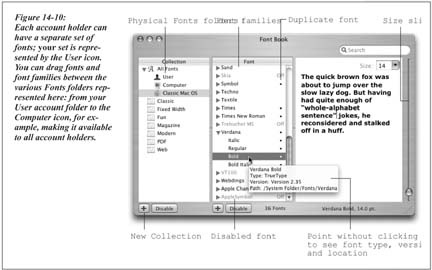Fonts—and Font Book
Over the years, Macintosh fonts have improved considerably. No longer must you pray to the printer gods that your beautiful flyer won't come out with jagged-looking type because you chose the wrong font type, one that doesn't have smooth edges.

Figure 14-10. Each account holder can have a separate set of fonts; your set is represented by the User icon. You can drag fonts and font families between the various Fonts folders represented here: from your User account folder to the Computer icon, for example, making it available to all account holders.
Mac OS X delivers type that is all smooth, all the time. Fonts in Tiger's formats— called TrueType, PostScript Type 1, and OpenType—always look smooth onscreen and in printouts, no matter what the point size.
Tiger comes with a program that's just for installing, removing, inspecting, and organizing fonts. It's called Font Book (Figure 14-10), and it's in your Applications folder.
Where Fonts Live
If you're used to Mac OS 9 or Windows, one of the most confusing changes is that there's no longer one single Fonts folder for your computer. There are now five Fonts folders. The fonts you actually see listed in the Fonts menus and Font panels of your programs are combinations of these Fonts folders' contents. They include:
your private fonts (your Home folder→Library→Fonts). This Fonts folder sits right inside your own Home folder. ...
Get Mac OS X: The Missing Manual, Tiger Edition now with the O’Reilly learning platform.
O’Reilly members experience books, live events, courses curated by job role, and more from O’Reilly and nearly 200 top publishers.

